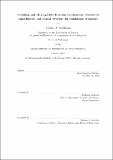| dc.contributor.advisor | Wolfgang Ketterle. | en_US |
| dc.contributor.author | Chikkatur, Ananth P., 1975- | en_US |
| dc.contributor.other | Massachusetts Institute of Technology. Dept. of Physics. | en_US |
| dc.date.accessioned | 2005-05-19T15:14:27Z | |
| dc.date.available | 2005-05-19T15:14:27Z | |
| dc.date.copyright | 2002 | en_US |
| dc.date.issued | 2003 | en_US |
| dc.identifier.uri | http://hdl.handle.net/1721.1/16907 | |
| dc.description | Thesis (Ph. D.)--Massachusetts Institute of Technology, Dept. of Physics, February 2003. | en_US |
| dc.description | Includes bibliographical references (p. 173-184). | en_US |
| dc.description | This electronic version was submitted by the student author. The certified thesis is available in the Institute Archives and Special Collections. | en_US |
| dc.description.abstract | In this thesis, two different sets of experiments are described. The first is an exploration of the microscopic superfluidity of dilute gaseous Bose-Einstein condensates. The second set of experiments were performed using transported condensates in a new BEC apparatus. Superfluidity was probed by moving impurities through a trapped condensate. The impurities were created using an optical Raman transition, which transferred a small fraction of the atoms into an untrapped hyperfine state. A dramatic reduction in the collisions between the moving impurities and the condensate was observed when the velocity of the impurities was close to the speed of sound of the condensate. This reduction was attributed to the superfluid properties of a BEC. In addition, we observed an increase in the collisional density as the number of impurity atoms increased. This enhancement is an indication of bosonic stimulation by the occupied final states. This stimulation was observed both at small and large velocities relative to the speed of sound. A theoretical calculation of the effect of finite temperature indicated that collision rate should be enhanced at small velocities due to thermal excitations. However, in the current experiments we were insensitive to this effect. Finally, the factor of two between the collisional rate between indistinguishable and distinguishable atoms was confirmed. A new BEC apparatus that can transport condensates using optical tweezers was constructed. Condensates containing 10-15 million sodium atoms were produced in 20 s using conventional BEC production techniques. These condensates were then transferred into an optical trap that was translated from the 'production chamber' into a separate vacuum chamber: the 'science chamber'. | en_US |
| dc.description.abstract | (cont.) Typically, we transferred 2-3 million condensed atoms in less than 2 s. This transport technique avoids optical and mechanical constrainsts of conventional condensate experiments and allows for the possibility of novel experiments. In the first experiments using transported BEC, we loaded condensed atoms from the optical tweezers into both macroscopic and miniaturized magnetic traps. Using microfabricated wires on a silicon chip, we observed excitation-less propagation of a BEC in a magnetic waveguide. The condensates fragmented when brought very close to the wire surface indicating that imperfections in the fabrication process might limit future experiments. Finally, we generated a continuous BEC source by periodically replenishing a condensate held in an optical reservoir trap using fresh condensates delivered using optical tweezers. More than a million condensed atoms were always present in the continuous source, raising the possibility of realizing a truly continuous atom laser. | en_US |
| dc.description.statementofresponsibility | by Ananth P. Chikkatur. | en_US |
| dc.format.extent | 184 p. | en_US |
| dc.format.extent | 2922477 bytes | |
| dc.format.extent | 2922131 bytes | |
| dc.format.mimetype | application/pdf | |
| dc.format.mimetype | application/pdf | |
| dc.language.iso | eng | en_US |
| dc.publisher | Massachusetts Institute of Technology | en_US |
| dc.rights | M.I.T. theses are protected by copyright. They may be viewed from this source for any purpose, but reproduction or distribution in any format is prohibited without written permission. See provided URL for inquiries about permission. | en_US |
| dc.rights.uri | http://dspace.mit.edu/handle/1721.1/7582 | |
| dc.subject | Physics. | en_US |
| dc.title | Colliding and moving Bose-Einstein condensates : studies of superfluidity and optical tweezers for condensate transport | en_US |
| dc.type | Thesis | en_US |
| dc.description.degree | Ph.D. | en_US |
| dc.contributor.department | Massachusetts Institute of Technology. Department of Physics | |
| dc.identifier.oclc | 52569300 | en_US |
